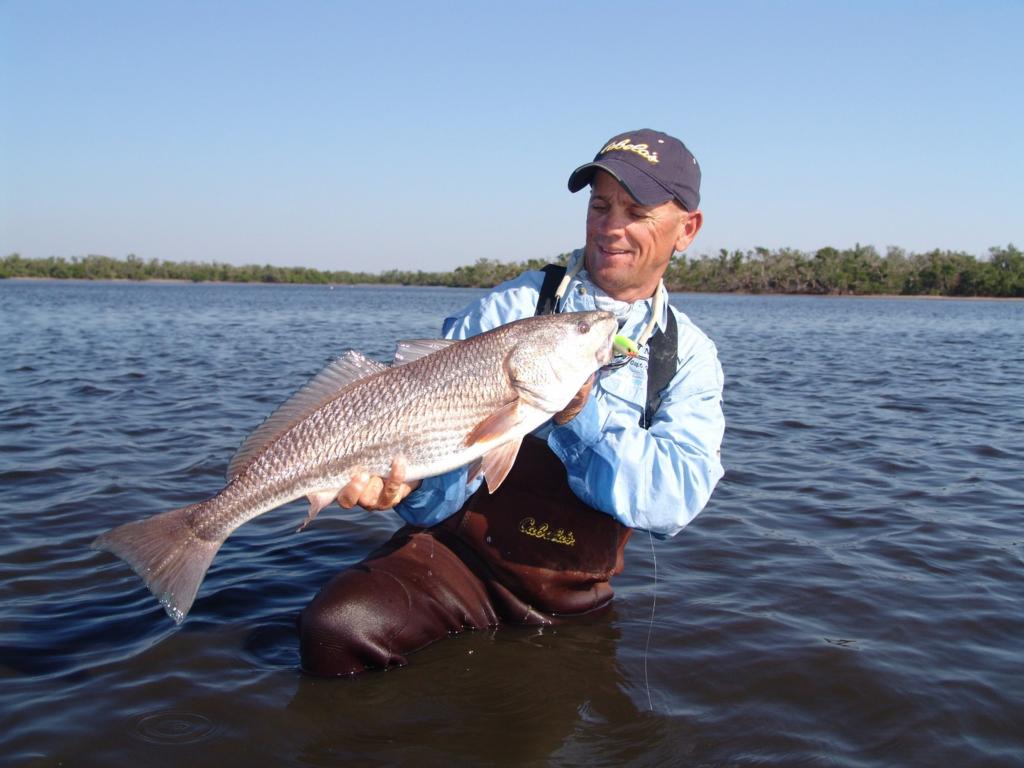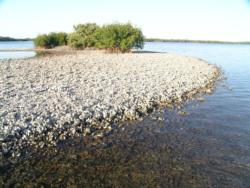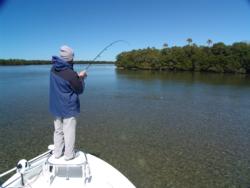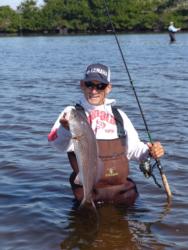Timing winter redfish
High, low tides offer strategic opportunities

Redfish aren’t a complicated lot – they just want to eat and feel safe doing so. A slave to the tides, this fish plans its comings and goings around water levels. Master this schedule and you’ll keep warm with cool-season fishing.
Late fall-winter sees the year’s lowest tides – particularly those occurring on or near full and new moons. When strong, north winds hasten the falling tide – and sometimes hold back the incoming effort – flats go bone dry, and redfish drop into nearby cuts, channels and holes.
During this season, two different strategies often lead to redfish success. One involves moving toward high ground; the other leverages something close to the old “fish-in-a-barrel” cliche.
Island hopping
Verdant vistas, secluded settings and endless seafood buffets may sound like something out of a Caribbean tourism brochure, but we’re not talking about vacation plans – this is Redfish 101. Indeed, the barrier islands, keys and glorified mangrove hills scattered along Florida’s west coast harbor loads of shrimp, crabs, invertebrates and baitfish that reds favor. The fish just need sufficient depth to reach the food.
 As the tide rises, picking your way through a labyrinth of sand bars and oyster barricades is challenging. However, a well-timed approach can yield tremendous redfish action with clockwork dependability.
As the tide rises, picking your way through a labyrinth of sand bars and oyster barricades is challenging. However, a well-timed approach can yield tremendous redfish action with clockwork dependability.
Around most island perimeters, redfish forage in deeper grass and belly into cozy potholes during low water periods. Instinct compels them to move up and dine at the feeding stations around mangroves and oyster outcroppings, but tide level governs when they arrive. As the tide ebbs, the fish simply slide into adjacent cuts and channels. Here, they tarry until the incoming cycle paves the path to a briny chow line.
For anglers, arriving on high water means proceeding right to the action. However, starting at the low end requires a more patient advance. The incoming water will gain momentum gradually, so until you notice significant movement, stick to the outer potholes where blind-casting to the grassy edges will often tempt bored redfish, along with neighboring speckled trout.
Once the tide picks up steam, select a shoreline point and move forward. Winter water is typically superclear, so you should be able to spot and avoid sand bars. Polarized sunglasses aid your visibility, while local charts will reveal safe approach lanes.
Shut down the outboard a couple football fields from your target and use the trolling motor to ease into drifting range. Whenever possible, cut all power and leverage the combination of wind and incoming water to push your boat closer to where the fish are likely to stage.
Along the way, puffs of mud mark the sudden departure or resting reds. These aren’t catchable fish, but stealth is nonetheless paramount. In high visibility, redfish become so sensitive that even the bump of a push pole hitting bottom can spook them. Inside the boat, find a comfortable position and glue your feet to the deck. Dropping pliers, rattling tackle trays and slamming hatches spells doom, so measure your every move.
While easing across shallow grass beds, you’ll probably encounter long, thin lines of barren bottom – prop scars left by careless boaters who pushed too far into the meager depths and then bullied their way out of the area under outboard power. Fragile sea grass beds provide nursery habitat for many coastal species, so go slow in skinny water to avoid such senseless damage.
Once the rising water floods the island shores, it’s game on, but keep your distance – reds don’t appreciate unannounced company at the dinner table. Armed with 7- to 7 1/2-foot rods with 12- to 20-pound braided line and 30-pound fluorocarbon leaders, your best bet is to ease along the shoreline, a good cast off the edge, and watch for wakes, pushes and boils that indicate feeding reds. Tailing is  common here, as reds nose down to root out a meal and wave their backsides above the surface for balance.
common here, as reds nose down to root out a meal and wave their backsides above the surface for balance.
When you locate fish or attractive features like a deep trough or sizable oyster bar, stake out and work the area with blind-casting or targeted shots to visible fish. Ideal for this stop-and-go routine is the Power-Pole – a hydraulic arm mounted to a boat’s transom that drives a composite spike into the bottom for quick position control with minimal environmental impact. Lacking this accessory, a small mushroom anchor will suffice, but keep a thick towel at your stern to muffle anchor noise between uses.
Reds will be focused on bottom feeding around island shores, so subsurface baits work best. You’ll never go wrong with a weedless gold spoon, but grub tails or soft-plastic jerkbaits on 1/8- to ¼-ounce jigs – or 4/0 hooks with weighted shanks and shrimp imitators – also do the trick. Remember, redfish feed largely by smell, so Berkley Gulp and other scented baits are an easy sell to foraging reds. (If the reds play hard to get, try dead-sticking a scented bait along their travel lane.)
Mullet march
Now, despite the clear advantages of rising water – oxygen renewal, forage delivery, expanded feeding range – low tide can also prove advantageous for redfish seekers. During those extreme winter lows, reds fall into deep holes and troughs in the backwaters of south Tampa Bay and Charlotte Harbor, where they become trapped for several hours.
Why do the fish put themselves in such a position? Simple – easy meals.
Exemplifying the opportunistic nature hard-wired into the psyche of all predators, redfish mingle with the massive herds of mullet staging in these backwater coves prior to their seaward spawning runs. The mullet will move in and out a few times during the cool season, and when their numbers blacken the inner shallows, you can bet the farm that every redfish with a working mouth will follow these ambling vegetarians to scoop up the crabs, shrimp and pinfish displaced by thousands of silver bodies.
Given the redfish’s fixation on feeding, the lower visibility due to mullet-muddied waters and the fact that low-tide barriers limit outboard boat access, the term “turkey shoot” isn’t far from the truth. Fishing kayaks are all the rage lately, but most backwater mullet-mania spots sit farther than most folks care to paddle. Airboats offer a go-anywhere option, but for the average flats or bay boat angler, anchoring  outside the shallow stuff and wading into the hot zone works best.
outside the shallow stuff and wading into the hot zone works best.
Given the season’s declining water temperatures, neoprene waders are a must. Sizes vary, but 3-milimeter or 5-milimeter thickness is right for the Central Gulf Coast. Thicker is generally better, as you can always roll down the tops on warm days, but you can make thin waders thicker when the mercury plummets.
Also, go with stocking-foot waders and a pair of sturdy wading boots – better traction for soft bottom, which tends to suck boot-foot waders off your feet. Buy wading boots two sizes larger than your shoes to accommodate wader material.
For optimal traction, keep your knees bent like you’re water skiing, slide your feet and aim for the sandy spots. Walking over grass inflicts little environmental impact, but traversing the soft surface requires more energy, so you’ll tire faster. Moreover, be careful when wading the edges of deep cuts. Soft bottom or shell edges can suddenly give way, and even good swimmers will find themselves in potential peril when heavy waders fill up with chilly water.
Jigs, soft-plastic jerkbaits and shrimp imitators are the standard fare for mullet-school reds, but don’t hesitate to sling a noisy topwater right into the turbulent water. As with island fishing, proximity rules, so keep your distance. Mullet spook easily, and a dashing school will take the reds with them.
Fortunately, none of these fish can go very far, so with patience, persistence and a little more wading, you’ll usually find another group of cooperative fish looking for lunch in their low-water sanctuary.